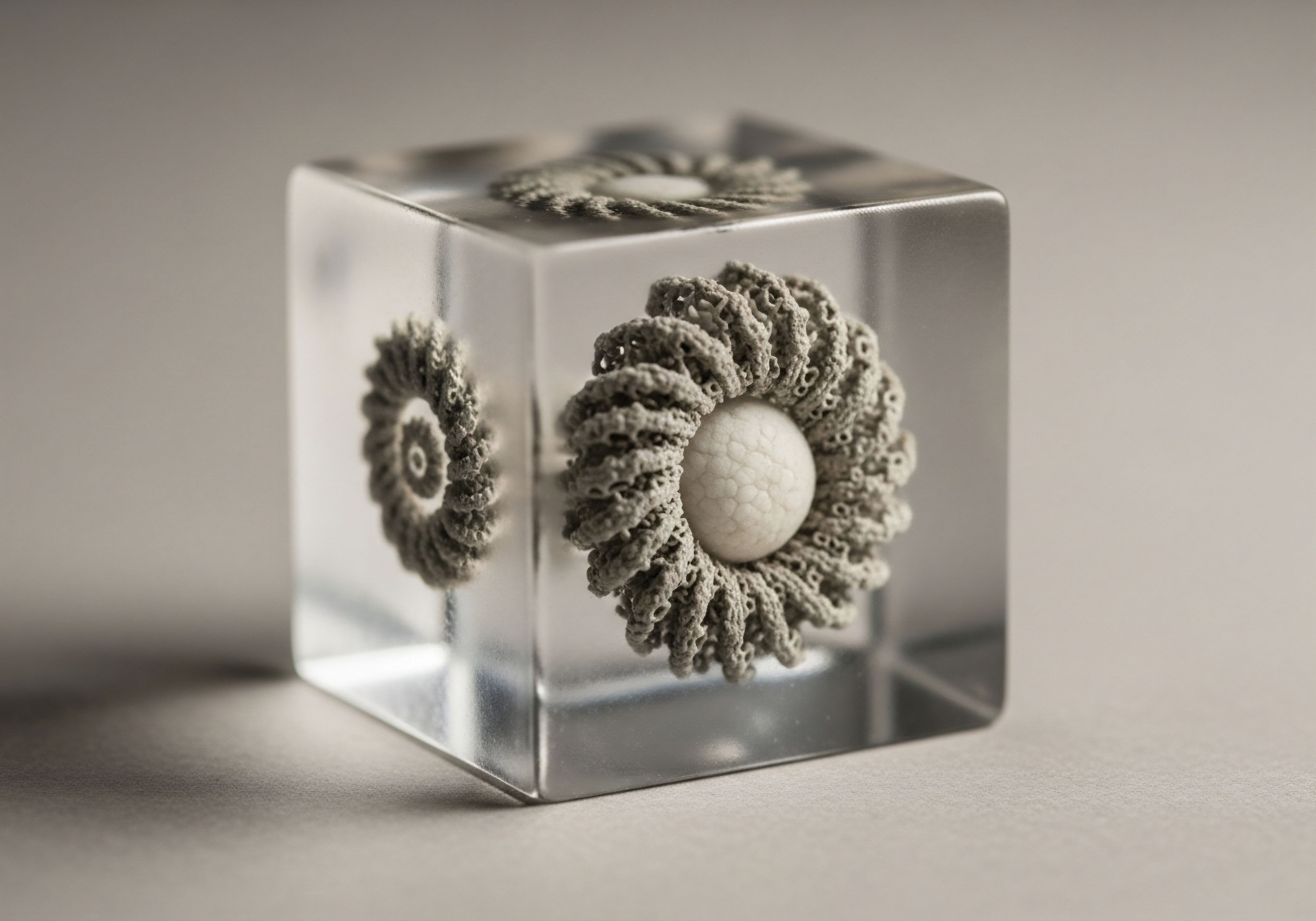

Fundamentals
The experience of Premenstrual Dysphoric Disorder, or PMDD, is a deeply personal and often isolating one. It is a cyclical storm of emotional and physical symptoms that arrives with predictable regularity in the days or weeks before menstruation, only to vanish just as quickly with its onset.
This pattern is the key to understanding that what you are feeling is a direct, biological response to the powerful hormonal shifts occurring within your body. The feelings of profound sadness, irritability, and anxiety, paired with physical discomforts like bloating and breast tenderness, are not a reflection of your character or strength.
They are signals from a system that is exquisitely sensitive to the rhythmic rise and fall of its own chemical messengers. The journey to managing PMDD begins with this validation. Your experience is real, it is rooted in your physiology, and there are logical, evidence-based paths toward reclaiming control over your well-being.
At its core, PMDD is understood as a severe, adverse reaction in the brain to the natural fluctuations of estrogen and progesterone during the luteal phase of the menstrual cycle ∞ the time after ovulation and before your period begins. For reasons that are still being uncovered, individuals with PMDD appear to have a heightened sensitivity to these hormonal changes.
This sensitivity seems to be particularly linked to the way these hormones interact with key neurotransmitter systems in the brain, most notably serotonin. Serotonin is a critical regulator of mood, sleep, and appetite. When its function is disrupted by the hormonal shifts of the luteal phase, the debilitating psychological symptoms of PMDD can manifest.
Therefore, the cyclical nature of your symptoms is the most important diagnostic clue, confirming a direct link between your internal hormonal environment and your subjective experience of well-being.

The Central Role of Serotonin
The connection between hormonal fluctuations and serotonin provides a crucial window into why certain treatments are effective. In women susceptible to PMDD, the drop in estrogen and the rise in progesterone metabolites following ovulation can lead to a temporary decrease in serotonin activity.
This can feel like a sudden depletion of your emotional reserves, leading to the characteristic mood symptoms of the disorder. It explains why you might feel perfectly fine for most of the month, only to be plunged into a state of distress as your cycle progresses.
Recognizing this link is the first step in demystifying the condition. The symptoms are not random; they are a predictable outcome of a specific neurochemical response to a normal biological process. This understanding shifts the focus from self-blame to a more empowered perspective centered on biochemical recalibration.

Hormones as Conductors of an Orchestra
Your endocrine system functions like a complex orchestra, with hormones acting as the conductors of various sections. Estrogen and progesterone are two of the most powerful conductors in the female body, influencing everything from reproductive function to brain chemistry.
In the context of PMDD, the issue is not necessarily that the levels of these hormones are abnormal, but that the brain’s response to their normal cyclical changes is atypical. This is a critical distinction. It suggests that the solution lies in either stabilizing the hormonal fluctuations or modulating the brain’s response to them.
This dual approach forms the basis of the two primary treatment modalities for PMDD ∞ hormonal therapies, which aim to quiet the hormonal symphony, and SSRIs, which aim to retune the instruments in the brain’s orchestra to be less reactive to the hormonal conductors.


Intermediate
When considering treatment options for Premenstrual Dysphoric Disorder, we are essentially choosing between two distinct yet equally valid strategies. The first involves intervening at the source of the cyclical hormonal fluctuations, effectively preventing the triggers that lead to symptoms.
The second strategy focuses on modulating the brain’s response to these hormonal signals, bolstering the neurochemical systems that are destabilized by them. Selective Serotonin Reuptake Inhibitors (SSRIs) represent the second approach, while hormonal therapies embody the first. The decision between these two paths depends on a variety of factors, including the severity of symptoms, the presence of co-occurring conditions, and an individual’s personal health goals and preferences.
The choice between hormonal therapies and SSRIs for PMDD hinges on whether the goal is to suppress the hormonal trigger or to modulate the brain’s response.
SSRIs are considered a first-line treatment for PMDD due to their robust efficacy and rapid onset of action in this specific context. Unlike their use in major depressive disorder, which can take several weeks to become effective, SSRIs can alleviate PMDD symptoms within days.
This suggests a different mechanism of action is at play. One leading hypothesis is that SSRIs, in the context of PMDD, rapidly increase the brain’s levels of allopregnanolone, a neurosteroid derived from progesterone that has a calming, anti-anxiety effect. In women with PMDD, there may be a paradoxical or blunted response to the natural fluctuations of allopregnanolone. SSRIs may help to normalize this response, effectively restoring the brain’s equilibrium during the challenging luteal phase.

A Closer Look at SSRI Protocols
SSRIs can be administered for PMDD in a few different ways, offering flexibility in treatment. The most common protocols include:
- Continuous Dosing This involves taking the medication every day of the month. This approach is often recommended for individuals with severe symptoms or for those who find it difficult to track their cycle.
- Luteal Phase Dosing This protocol involves taking the medication only during the luteal phase, typically starting around day 14 of the cycle and stopping at the onset of menstruation. This approach can be equally effective as continuous dosing for many women and may reduce the overall side effect burden.
- Symptom-Onset Dosing In this approach, the medication is started as soon as symptoms appear and is continued until the first few days of menstruation. This method requires a high degree of self-awareness but can be a good option for women with shorter symptomatic windows.

Hormonal Therapies a Different Approach
Hormonal therapies for PMDD work by suppressing ovulation and the subsequent cyclical fluctuations of estrogen and progesterone that trigger symptoms. By creating a more stable hormonal environment, these treatments prevent the cascade of events that leads to the destabilization of neurotransmitter systems in the brain. The most common hormonal interventions for PMDD include:
- Combined Oral Contraceptives (COCs) Certain COCs, particularly those containing the progestin drospirenone, have been shown to be effective in managing PMDD symptoms. Drospirenone is unique in that it has anti-androgenic properties and can help to reduce some of the negative mood effects associated with other progestins.
- Gonadotropin-Releasing Hormone (GnRH) Agonists For severe, refractory cases of PMDD, GnRH agonists can be used. These medications create a temporary, reversible menopause-like state by shutting down the production of estrogen and progesterone from the ovaries. While highly effective, they are typically used as a second or third-line treatment due to the potential for side effects associated with low estrogen levels, such as hot flashes and bone density loss. To mitigate these effects, a low dose of “add-back” hormone therapy (estrogen and progesterone) is often prescribed alongside the GnRH agonist.

How Do Hormonal Therapies Compare to SSRIs for PMDD Symptom Management?
The choice between SSRIs and hormonal therapies is a nuanced one. SSRIs are generally the preferred first-line treatment due to their strong evidence base and rapid action. They directly target the neurochemical imbalances that are thought to underlie the mood symptoms of PMDD. Hormonal therapies, on the other hand, address the root hormonal trigger.
They can be an excellent option for women who also desire contraception or who have not responded to or cannot tolerate SSRIs. The following table provides a comparative overview of the two approaches:
| Feature | SSRIs | Hormonal Therapies (COCs) |
|---|---|---|
| Primary Mechanism | Modulates serotonin system in the brain | Suppresses ovulation and hormonal fluctuations |
| Onset of Action | Rapid (within days) | May take 1-3 cycles to see full effect |
| Dosing Flexibility | Continuous, luteal phase, or symptom-onset | Continuous daily use |
| Contraceptive Benefit | No | Yes |
| Common Side Effects | Nausea, headache, fatigue, decreased libido | Breakthrough bleeding, breast tenderness, nausea |


Academic
A deeper, academic exploration of PMDD treatment requires a shift in perspective from viewing the condition as a simple hormone or neurotransmitter deficiency to understanding it as a disorder of cellular and network-level sensitivity to hormonal flux.
The core of PMDD pathophysiology appears to be a genetically-influenced, tissue-specific alteration in the molecular response to gonadal steroids within the central nervous system. This is a critical distinction because it reframes the therapeutic challenge. We are not merely correcting a chemical imbalance; we are attempting to compensate for an aberrant biological response programmed at a fundamental level.
This perspective helps to explain why treatments that stabilize the internal hormonal milieu, or those that directly buffer the downstream neurochemical consequences, are the most effective interventions.
The pathophysiology of PMDD is increasingly understood as a genetically programmed hypersensitivity of brain circuits to normal hormonal changes.
The serotonergic system’s involvement in PMDD is well-established, but the mechanism by which SSRIs exert their rapid therapeutic effect is a subject of intense investigation. The leading hypothesis centers on their ability to modulate the synthesis and activity of neuroactive steroids, particularly allopregnanolone (ALLO).
ALLO is a potent positive allosteric modulator of the GABA-A receptor, the primary inhibitory neurotransmitter system in the brain. In healthy women, ALLO levels rise during the luteal phase, contributing to a sense of calm.
In women with PMDD, however, there appears to be a dysregulated response to this neurosteroid, potentially involving a paradoxical anxiety-provoking effect or a blunted sensitivity at the receptor level. SSRIs may work by rapidly restoring homeostatic ALLO signaling, thereby stabilizing GABAergic tone and alleviating the affective and anxious symptoms of PMDD. This is a departure from the classical understanding of SSRI action in depression, which is thought to rely on longer-term neuroplastic changes.

What Is the Role of the HPG Axis in PMDD?
The Hypothalamic-Pituitary-Gonadal (HPG) axis is the master regulator of the menstrual cycle. Hormonal therapies for PMDD, such as combined oral contraceptives and GnRH agonists, exert their effects by interrupting this axis at different points. COCs provide a steady, exogenous dose of estrogen and progestin, which suppresses the release of GnRH from the hypothalamus, and subsequently, FSH and LH from the pituitary.
This prevents ovulation and the endogenous production of estrogen and progesterone by the ovaries, thus eliminating the cyclical hormonal fluctuations that trigger PMDD symptoms. GnRH agonists work further up the chain of command by binding to and desensitizing GnRH receptors in the pituitary, leading to a profound suppression of ovarian steroidogenesis. This creates a state of medical menopause, which, while highly effective for PMDD, necessitates add-back therapy to prevent the systemic consequences of estrogen deficiency.

Comparative Efficacy a Deeper Dive
When comparing SSRIs and hormonal therapies, it is essential to consider the specific symptom clusters being targeted. Research suggests that SSRIs are particularly effective for the core psychological symptoms of PMDD, such as irritability, anger, and depression. Their efficacy for physical symptoms is less consistent. Hormonal therapies, particularly COCs containing drospirenone, may offer a more balanced improvement across both psychological and physical domains. The following table provides a more detailed comparison of the two primary hormonal interventions for PMDD:
| Intervention | Mechanism of Action | Primary Indication | Key Considerations |
|---|---|---|---|
| Drospirenone-Containing COCs | Suppresses ovulation; drospirenone has anti-mineralocorticoid and anti-androgenic properties. | Moderate to severe PMDD in women desiring contraception. | May take several cycles for full effect; potential for breakthrough bleeding. |
| GnRH Agonists with Add-Back Therapy | Induces a state of medical menopause by suppressing the HPG axis. | Severe, refractory PMDD unresponsive to other treatments. | Requires careful management of add-back therapy to mitigate menopausal side effects. |
The decision to use a GnRH agonist is a significant one, reserved for the most debilitating cases. It is a powerful demonstration of the principle that eliminating the hormonal trigger can completely resolve PMDD symptoms, confirming the central role of ovarian steroid fluctuations in the disorder’s pathophysiology.
The necessity of add-back therapy also underscores the systemic importance of estrogen and progesterone for overall health, particularly bone and cardiovascular health. Ultimately, the choice of treatment must be individualized, taking into account the complex interplay of an individual’s unique biology, symptom presentation, and life circumstances.

References
- Singh, Pallavi, et al. “AN OVERVIEWOF THE PATHOPHYSIOLOGY AND TREATMENT OF PREMENSTRUAL DYSPHORIC DISORDER.” Journal of Pharmaceutical Negative Results, vol. 13, no. S09, 2022, pp. 1735-41.
- Hantsoo, Liisa, and C. Neill Epperson. “Premenstrual Dysphoric Disorder ∞ Epidemiology and Treatment.” Current Psychiatry Reports, vol. 17, no. 11, 2015, p. 87.
- Reid, Robert L. “Premenstrual Dysphoric Disorder (Formerly Premenstrual Syndrome).” MDText.com, Inc., 2000.
- Yonkers, Kimberly Ann, et al. “Efficacy of a new low-dose oral contraceptive with drospirenone in premenstrual dysphoric disorder.” Obstetrics & Gynecology, vol. 106, no. 3, 2005, pp. 492-501.
- Nevatte, T. et al. “Recent advances in understanding and managing premenstrual dysphoric disorder.” F1000Prime Reports, vol. 5, 2013.

Reflection
The information presented here provides a map of the current clinical understanding of Premenstrual Dysphoric Disorder and its management. This map, with its detailed pathways and intersections, is a tool for understanding the biological terrain of your own body. It offers a framework for interpreting your experiences and for engaging in informed conversations with healthcare providers.
The ultimate goal of this knowledge is to empower you to move forward on a path toward personalized wellness. Your health journey is unique, and the insights you have gained are the first step in navigating it with confidence and clarity. The path to reclaiming your vitality is a collaborative one, built on a foundation of self-knowledge and expert guidance.

Glossary

premenstrual dysphoric disorder

pmdd

estrogen and progesterone

luteal phase

serotonin

hormonal fluctuations

progesterone

estrogen

hormonal therapies

ssris

allopregnanolone

combined oral contraceptives

drospirenone

gnrh agonists

neuroactive steroids




